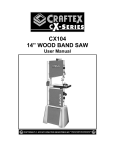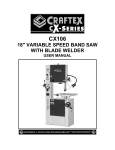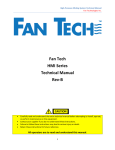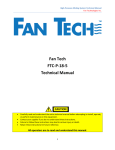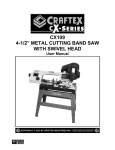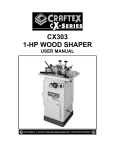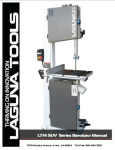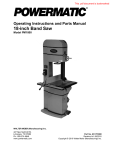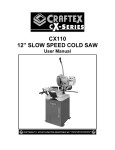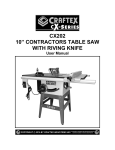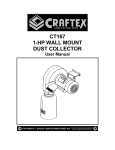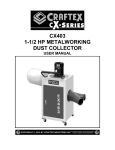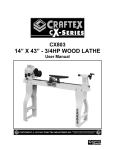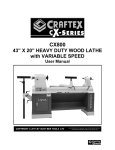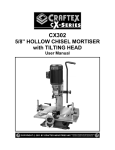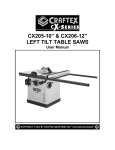Download 12" WOOD / METAL BAND SAW
Transcript
CX115 12" WOOD / METAL BAND SAW USER MANUAL Version 1.0 TABLE OF CONTENTS General Safety Instructions-----------------------------------------------------------------Specific Safety Instructions -----------------------------------------------------------------Features -----------------------------------------------------------------------------------------Physical Features ------------------------------------------------------------------------------ 3 4 5 6 Un-packing--------------------------------------------------------------------------------------- 7 Setup ---------------------------------------------------------------------------------------------- 7 Proper Grounding ------------------------------------------------------------------------------ 7 Stand Assembly -------------------------------------------------------------------------------- 9 Table Assembly--------------------------------------------------------------------------------- 9 Crank Handle------------------------------------------------------------------------------------ 9 Blade Tensioning Wheel --------------------------------------------------------------------- 9 Rip Fence ---------------------------------------------------------------------------------------- 9 Blade Tracking Adjustment ----------------------------------------------------------------- 10 ON/OFF Switch --------------------------------------------------------------------------------- 10 Test Run------------------------------------------------------------------------------------------ 11 Dust Collection---------------------------------------------------------------------------------- 12 Support Bearings Adjustment --------------------------------------------------------------- 12 Table Adjustment------------------------------------------------------------------------------- 13 Table Tilt------------------------------------------------------------------------------------------ 14 Speed Change Settings ---------------------------------------------------------------------- 14 Blade Replacement---------------------------------------------------------------------------- 15 Tensioning the Blade-------------------------------------------------------------------------- 16 Work-piece Inspection (Wood)-------------------------------------------------------------- 16 Work-piece Inspection (Metal) -------------------------------------------------------------- 17 Operations --------------------------------------------------------------------------------------- 18 Ripping-------------------------------------------------------------------------------------------- 18 Crosscutting ------------------------------------------------------------------------------------- þ8 Resawing----------------------------------------------------------------------------------------- 18 Cutting Curves ---------------------------------------------------------------------------------- 18 Maintenance------------------------------------------------------------------------------------- 19 Cleaning and Lubrication--------------------------------------------------------------------- 19 Drive Belt ----------------------------------------------------------------------------------------- 19 Stand Parts Diagram & Parts List --------------------------------------------------------21-22 Band Saw Diagram & Parts List ----------------------------------------------------------23-24 Blade Guides & Table Parts Diagram & Parts List-----------------------------------25-26 Drive Parts Diagram & Parts List ---------------------------------------------------------27-28 Gearbox Parts Diagram & Parts List ----------------------------------------------------29-30 Warranty -------------------------------------------------------------------------------------------- 31 2 GENERAL SAFETY INSTRUCTIONS Extreme caution should be used when operating all power tools. Know your power tool, be familiar with its operation, read through the owner’s manual and practice safe usage procedures at all times. ALWAYS read and understand the user manual before operating the machine. DISCONNECT the power source when changing blade and / or making adjustments. CONNECT your machine ONLY to the matched and specific power source. NEVER leave a tool unattended while it is in operation. ALWAYS wear safety glasses respirators, hearing protection and safety shoes, when operating your machine. NEVER reach over the table when the tool is in operation. DO NOT wear loose clothing or jewelry when operating your machine. A SAFE ENVIRONMENT is important. Keep the area free of dust, dirt and other debris in the immediate vicinity of your machine. BE ALERT! DO NOT use prescription or other drugs that may affect your ability or judgment to safely use your machine. ALWAYS keep blades, knives and bits sharpened and properly aligned. ALL OPERATIONS MUST BE performed with the guards in place to ensure safety. ALWAYS use push sticks and feather boards to safely feed your work through the machine. ALWAYS make sure that any tools used for adjustments are removed before operating the machine. 3 CX115 12" WOOD / METAL BAND SAW SPECIFIC SAFETY INSTRUCTIONS ALWAYS INSPECT the blade for any cracked or missing teeth before operating the band saw. ALWAYS ENSURE that the blade tension is properly set for the type and width of blade installed. NEVER place your fingers or hands in the line of cut. If you slip, your hands or fingers may come into contact with the blade. Always use a push stick when ripping narrow pieces. DO NOT back the work-piece away from the blade while cutting. Always turn off the machine if you are backing out a cut. ALL GAURDS must be in place while operating the band saw to ensure safety. ALWAYS FEED the stock smoothly. Do not force or twist the work-piece while cutting. ALWAYS ENSURE that the band saw blade guard is no more than 1/2” above the stock. MAKE SURE before making any adjustments, the switch is in the “OFF” position and the cord is un-plugged from the power source. NEVER LEAVE the band unattended while it is running. saw DO NOT attempt to remove jammed pieces unless the band saw has come to a complete stop and the power switch has been turned to the OFF position. ALWAYS ENSURE that the guide blocks are properly set to prevent blade wander. ALWAYS MAKE CERTAIN that the bearings are properly adjusted to guide the blade. MAINTAIN AND SERVICE your band saw regularly as instructed in the user manual. MAKE SURE you have read and understood all the safety instructions in the manual and you are familiar with your band saw, before operating the CX115. If you fail to do so, serious injury could occur. DO NOT TURN ON the band saw if the blade is in contact with your stock. WARNING! The safety instructions given above can not be complete because the environment in every shop is different. Always consider safety first as it applies to your individual working conditions. 4 CX115 WOOD / METAL BAND SAW FEATURES MODEL CX115 - 12” WOOD / METAL BAND SAW As part of the growing line of Craftex CX-Series, we are proud to offer the CX115 a 12” Wood / Metal Band Saw. By following the instructions and procedures laid out in this user manual, you will receive years of excellent service and satisfaction. The CX115 is a professional tool and like all power tools, proper care and safety procedures should be adhered to. Motor.............................................................3/4-HP, 110-V, Single Phase Switch ...........................................................ON/OFF Switch 4 Speeds.......................................................80, 180, 1300 & 3,000 FPM Cast Iron Table Size .....................................15" x 15"þ Table Tilt .......................................................0° Left & 45° Right Wheel Diameter ............................................12-3/8" Blade Width...................................................1/8" to 1/2" Blade Length.................................................89-3/4" Maximum Depth of Cut .................................7" Maximum Depth of Cut at 45°.......................4" Depth of Throat .............................................12" Dust Collection Port ......................................4" Bearings........................................................Sealed and Permanently Lubricated Computer Balanced Cast Iron Wheels..........Yes Powder Coated Paint ....................................Yes Overall Dimension.........................................31" Width x 23" Length x 65" Height Approximate Weight......................................189 lbs Warranty .......................................................3 Years Country of Origin...........................................Taiwan 5 CX115 12” WOOD / METAL BAND SAW PHYSICAL FEATURES Blade Tension Hand Wheel Upper Cabinet Blade Tracking Window Upper Cabinet Lock Knob Blade Guard Lock Knob Rip Fence ON/OFF Switch Blade Guard Upper Blade Guides Cast Iron Table Rip Fence Lock Knob Lower Cabinet Gearbox Lever Belt Tensioning Crank Handle Lower Cabinet Lock Knob Stand Feet 6 UNPACKING The machine is properly packaged in a carton for safe transportation. When unpacking, carefully inspect the carton and ensure that nothing has been damaged during transit. The band saw should be wired with a plug having 3 prongs to fit a 3 prong grounded receptacle as shown in figure-3. Do not remove the grounding prong to fit it into a 2 pronged outlet. While doing the inventory if you can not find any part, check if the part is already installed on the machine. SETUP The unpainted surface of the table is coated with a rust preventive waxy oil and you will want to remove this before you begin assembly. Use a solvent cleaner that will not damage painted surfaces. Figure-1 110-volts outlet for CX115 When setting up your machine, you will want to find an ideal spot where your band saw will most likely be positioned most of the time. Consider your complete work environment before placing your machine in the ideal spot. Improper connection of the equipmentgrounding conductor can result in a risk of electric shock. Check with a qualified electrician if you are in doubt as to whether the outlet is properly grounded. PROPER GROUNDING Grounding provides a path of least resistance for electric current to reduce the risk of electric shock. CX115 is for use on a normal 110 volt circuit. Make sure that the machine is connected to an outlet having the same configuration as the plug. If an adaptor plug is used, it must be attached to the metal screw of the receptacle. To prevent electrical hazards, have a qualified electrician ensure that the line is properly wired. WARNING! It is strongly recommended not to use extension cords with your CX115. Always try to position your machine close to the power source so that you do not need to use extension cords. If it is necessary to use an extension cord, make sure the extension cord does not exceed 50-feet in length and the cord is 14gauge to prevent motor damage. 7 STAND ASSEMBLY To assemble the CX115 wood/metal band saw, follow the instructions given below: Attach the leg assemblies with the two lower and two upper short brackets using carriage bolts, washers and nuts provided. See figure-4. Attach the upper long brackets to the two stand legs and using carriage bolts, washers and nuts provided. Finger tighten the bolts for now. See figure-2. Figure-4 Attaching lower and upper short brackets to the legs assemblies Figure-2 Attaching upper long bracket to the legs Attach the lower long brackets to the leg assemblies by finger tightening the carriage bolts, washers and nuts provided. See figure-3. Once the stand is assembled, tighten all the nuts and bolts fully using a proper size wrench. Set the stand upside down and thread the feet with the hex nuts onto the ends of the stand legs and position back the stand up right. Adjust the stand height using the nut on the all four feet. See figure-5. Figure-5 Installing feet Get the help of an assistant, lifting the band saw up, and place it onto the stand. Secure it using head hex bolts and nuts provided. Figure-3 Attaching lower long bracket to the legs 8 TABLE ASSEMBLY Remove the stud in the table slot and carefully pass the saw blade through the table slot. Position the table onto the upper trunnion and secure it using four hex head bolts and washers shown in figure-6. Do not tighten the bolts completely at this time. Figure-6 Installing the table Install the table insert in the center of the table. Adjust the table so that the saw blade runs through the center of the table insert. When the saw blade is centered, secure the table in position by tightening all the hex bolts completely. Replace the stud into the table slot. BLADE TENSIONING WHEEL Thread the blade tensioning wheel onto the blade tensioning screws and tighten it. See figure-9. Figure-8 Installing blade tensioning wheel RIP FENCE The rip fence on the CX115 is designed to ride in the table slot. Position the rip fence on the table and secure it by tightening the knob into the rip fence shown in figure-9. CRANK HANDLE Install the crank handle on to the belt tensioning crank arm using a hex nut. Figure-9 Installing the rip fence To reposition the rip fence, simply loosen the knob. Figure-7 Installing the belt tensioning crank handle 9 BLADE TRACKING ADJUSTMENT The blade tracking refers to where blade rides on the upper and lower wheels. The blade should always be centered on both wheels. Although the blade tracking of this band saw is factory set, you should check it again to make sure that the blade is centered on the wheels. The blade tracking can be controlled by adjusting the upper wheel tilt knob. See figure-10. TURN THE KNOB CLOCKWISE: If the blade moves towards the front edge of the wheel. It makes the top of the wheel to tilt back and moves the blade towards the center. TURN THE KNOB ANTI-CLOCKWISE: If the blade moves towards the back edge of the wheel. It makes the top of the wheel to tilt to the front and moves the blade towards the center. When you have adjusted the blade tracking, retighten the lock nut. ON / OFF SWITCH The ON/Off switch is located on the left front of the saw column. to turn saw ON, pull the switch to the up position. To turn the saw OFF push the switch to the down position. The ON/OFF switch on the CX115 features a removable locking key which prevents from unauthorized use when removed. Figure-10 Blade tracking knob and lock nut Simply remove the locking key from the switch and the machine will not turn on. TO CHECK AND ADJUST THE BLADE TRACKING: Disconnect the machine from the power source and open the upper wheel cover. Rotate the upper wheel by hand slowly and watch through the tracking window how the blade rides on the wheel. If the blade is not properly aligned and needs to be adjusted, loosen the lock nut and turn the blade tracking adjustment knob shown in figure- 10. 10 Figure-11 ON/OFF switch removable locking key with the TEST RUN TO TEST RUN THE MACHINE: Once you have assembled your machine completely, it is then time for a test run to make sure that the machine works properly and is ready for operation. Remove all the tools used for assembling the machine components. Walk around the machine, ensure all nuts, bolts, and screws are tightened and the machine is properly assembled. READ THE MANUAL Before starting the band saw, make sure that you have read and understood the manual and you are familiar with the functions and safety features on this machine. Failure to do so may cause serious personal injury. Connect the cord to the power source and turn the machine ON. During the test run if there is any unusual noise coming from the machine or the machine vibrates excessively, turn OFF the power switch immediately and disconnect the cord from the power source. Investigate if you can find out the problem with your machine. Turn the machine OFF. Remove the locking key from the ON/OFF switch and try to turn the on the machine. The machine should not turn on. WARNING! This machine can perform many types of operations which are beyond the scope of this manual and are very dangerous if performed incorrectly. The safety instructions given in this manual can not be complete because the environment in every shop is different. Always consider safety first as it applies to your individual working conditions. If the machine turns on with the locking key removed, turn it off immediately and disconnect the cord from the power source. The ON / OFF switch on the machine should be fixed before operating the band saw. If the machine does not run with the locking key removed, it means the ON/OFF switch is working properly. 11 DUST COLLECTION The CX115 features a 4” diameter dust port to collect to a dust collector. When using a dust collector, use the proper sized hose and make sure all the connections are sealed tightly. It is recommended to use a proper sized dust collector with the CX115 to ensure adequate dust collection. SUPPORT BEARINGS ADJUSTMENT The guide bearings (beside) and thrust bearing (behind) the blade, support the blade to move in a straight line during cutting operation. Properly adjusted support bearings play an important role in getting accurate cuts. TO ADJUST THE UPPER SUPPORT BEARINGS: Loosen the lock nut shown in figure-13 and move the guide carrier until the guide bearings are approximately 1/32" behind the gullets of the saw blade. Re-tighten the lock nut. Figure-12 Dust port WARNING! Loosen the locking screws on the bearings and turn the micro adjustment knobs and position the guide bearings approximately 0.02" (thickness of a sheet of paper) from the saw blade. Make sure not to position the guide bearings too close to the blade. See figure-14. The sawdust produced by the band saw can go into your lungs and cause serious health problems. Make sure the band saw is connected to a dust collection system while operating it. Figure-13 Adjusting the guide bearings Once the guide bearings are at the correct distance from the saw blade, re-tighten the locking screws on the guide bearings. Adjust the thrust bearing behind the saw blade, by loosening the locking screw on 12 the thrust bearing and turning the micro adjustment knob until the thrust bearing is approximately 1/64" behind the saw blade. See figure-14. Re-tighten the locking screws. Loosen the screw on the guide bearings and position the bearings so that the guide bearings are approximately 0.02” away from the blade and re-tighten the locking screws. See figure-15. TABLE ADJUSTMENT CX115 features a table stop which allows the table to easily come to 90° if the table is tilted. Figure-14 Adjusting the thrust bearing Once the correct adjustment is reached, lock the guide adjustment screw. TO ADJUST THE LOWER BLADE GUIDES: To adjust the table stop so that the table sits at 90°, you should first make sure the switch is in “OFF” position and the power cord is unplugged. Loosen the lock knob under the table. See figure-16. Loosen the lock nut and adjust the blade guide carrier so that the guide bearings are approximately 1/32" behind the gullets of the blade. See figure-15. Re-tighten the lock nut. Figure-16 Table stop bolt Place a square on the table as shown in figure-17. Figure-15 Adjusting the lower blade guides Loosen the screw on the thrust bearing and turn the micro adjustment knob so that the thrust bearing is 1/64” behind the blade. Figure-17 Squaring table with the blade 13 Loosen the lock nut on the table stop bolt shown in figure-16 and thread the table stop bolt in or out so that the square is touching the table and the blade with its full length and the table is at a 90° with the blade. Once the table is at 90° with the blade, retighten the lock nut on the table stop bolt and the lock knob under the table. TABLE TILT SCALE To calibrate the table tilt scale: Make sure the table is at 90° to the blade and the blade tensioning and tracking is properly set. (See Page-10 for Blade Tracking & page-16 for Blade Tensioning). Loosen the screw on the pointer shown in figure-18. Align the tip of the pointer with the “0” mark on the tilt scale and tighten the pointer screw. SPEED CHANGE SETTINGS The CX115 features 4-speed settings; 80, 180, 1300 and 3000 FPM. High cutting speeds are used on soft materials where less force is required and high rate of material is desired. Low cutting speeds are used on hard materials when more force is required. WARNING! Before attempting any speed changes make sure the switch is in the OFF position and the cord is disconnected from the power source. Failure to do so could in serious injury or damage to the machine. TO CHANGE THE SPEED: Make sure the switch is OFF and the cord is disconnected from the power source. Turn the crank handle shown in figure-19 clockwise to release the tension on the belt. Figure-18 Table tilt scale Figure-19 Crank handle Position the belt on the pulleys according to figure-20 for the desired speed. 14 Open the upper and lower cabinet doors by loosening the locking knobs on the doors. Loosen the blade tension by turning the blade tensioning wheel on the top part of the band saw counter clockwise until the saw blade tension is loose. See figure-21. Figure-20 Belt settings on the pulleys Once the belt is properly seated on the pulleys, tension the belt by turning the crank handle counter clockwise. Set the gearbox lever in the high or low position shown in figure-19 for the required speed. Open the cabinet door and turn the wheel slowly by hand and simultaneously shift the lever until the gears mesh completely. BLADE REPLACEMENT The CX115 comes with a general purpose saw blade. The blade gets dull with use and will need to be replaced. WARNING! Disconnect the cord from the power source before installing/removing any parts or servicing. Failure to do so could result in serious personal injury. Figure-21 Blade tensioning Knob Wear you protective gloves and remove the saw blade from the upper and lower wheels and slide it out through the slot on the table. Take the new saw blade and slide it through the slot on the table and install it onto the upper and lower wheels making sure that the blade teeth are pointing downwards and towards you at the position where the saw blade passes through the table. Close the cabinet doors and reinstall the rip fence. Once the blade is installed perform the following adjustments: TO CHANGE THE SAW BLADE: Make sure the switch is in the OFF position the cord is disconnected from the power source. Loosen the lock knob on the rip fence and remove the rip fence. Blade Tension Adjustment (See page-16) Blade Tracking Adjustment (See page-10) Support Bearings Adjustment (See page12) 15 TENSIONING THE BLADE A properly tensioned blade is very important to get the best performance from any band saw. If the blade is too loose there is a possibility that the blade will slip or drift off the line while in operation and it will be hard to have accuracy in the line of cut. If the blade is tensioned too tightly, it will be very difficult to make tighter radius cuts and there will be a great possibility of blade breakage. When using a wider blade for making straight cuts, for re-sawing or making wide radius cuts, tighter blade tension is recommended; while using narrower blades for cutting shorter stock or making tighter radius cuts, less blade tension is recommended. IMPORTANT The information above is just a guideline for you to understand to set the blade tension according to the cut. However, understanding the blade tension adjustment comes with practice. WORKPIECE INSPECTION (WOOD) Before cutting any wood, make sure to inspect the work-piece for nails, staples, small pieces of stone or metal and any other foreign object which is dangerous to come on contact with the blade. If the wood contains any of these objects and it comes in contact with the blade, the object might fly and hit the operator or seriously damage the blade. For safety, always inspect your work-piece carefully before cutting and wear eye protection. Some woods with excessive twisting or wrapping are un-stable while cutting and are dangerous to cut because during operation the work-piece can move unexpectedly which can either damage the blade or hurt the operator. TO TENSION THE SAW BLADE: If the wood is slightly cupped, make sure the cupped face of the wood is held against the fence. If the bowed side of the workpiece is held against the fence, the workpiece will move while cutting. Once the saw blade is installed on the wheels, turn the blade tensioning wheel clockwise to tension the saw blade. Some stock with large knots can damage the blade and wet stock will give a poor result. Reinstall the rip fence. Once the blade is tensioned properly, you will need to perform the saw blade tracking adjustment before operating the band saw. For blade tracking adjustment, see page10. IMPORTANT To prolong the life of your blade, loosen the tension on the saw blade when the band saw is not in use for a long period. 16 IMPORTANT The information above is just a guideline for you to understand how to cut a workpiece with slight cupping. If you are not sure and do not have any experience in cutting cupped stock, do not cut it. Failure to follow these instructions might bring personal injuries to the operator or serious damage to the blade. WORK-PIECE INSPECTION (METAL) Before cutting a metal work-piece, inspect it carefully for any defects in the material. For thin or small metals, the work-piece should be clamped between larger pieces to hold the work-piece tight, when fed against the blade. Some small work-pieces will be damaged if cut on the band saw; instead use; a shear or nibblers for this work. Some round work-pieces like cables, chains etc, which are not stable, if not supported with a vise, should not be cut using a vertical band saw. Some hard metals take a longer time when cutting. These kinds of metals need a different type of blade and lubrication while cutting. Tanks, cylinders, valves that contain gasses or liquids can cause fire, explosion or serious personal injury and damage to the machine. IMPORTANT Avoid cutting tanks, cylinders and valves that contain gasses or liquids if possible. If you find it really necessary to cut these items, always vent and purge them, before cutting. Sometimes it is not safe to cut magnesium. Cutting magnesium with a dull blade can create enough friction to make the small magnesium chips produce fire. Avoid cutting magnesium If possible. 17 OPERATIONS CROSSCUTTING Before operating the band saw make sure you have performed the following adjustments: Cutting solid wood across the grain and in plywood or metal cutting across the width of the work-piece is called crosscutting. Blade tension adjustment Blade tracking adjustment Support bearings adjustment Make sure all the guards are in place Mark the work-piece where you want to start the cut from and make sure the miter gauge is at 90° position on the miter slot. Place the work-piece on the table so that the marked point is aligned with the blade and hold the work-piece against the miter gauge. WARNING! Turn the band saw ON and feed the workpiece against the blade. The saw dust produced by the band saw can go into your lungs and cause serious health problems. Make sure the band saw is connected to a dust collection system while operating it. RIPPING Cutting solid wood with the grain cutting down the length of the work-piece is called ripping. Adjust the fence on the rails, according to the width of the cut on the work-piece and turn the hand-wheel to set the guide post assembly 1” above the work-piece. Now, turn the band saw ON and use a push stick pushing the work-piece against the blade. WARNING! Do not use your fingers to feed narrow work-pieces into the blade. If you slip, your fingers might come close the blade. Always use a push stick. 18 RESAWING Cutting a work-piece into two or more thinner pieces is called resawing. Wider blades give better result, when resawing. To resaw a work-piece make sure that the table is at a 90° with the blade and use a wider blade for better results. Adjust the fence according to the width of the cut you want, and lock it in position. Turn the band saw ON and feed the workpiece into the blade using feed paddles until the blade is completely through the workpiece. CUTTING CURVES For cutting curves always try to use narrower blades. When cutting curves feed the stock into the blade and turn it very carefully so that the blade follows the line of cut and make sure the blade does not twist. Make relief cuts through the waste part of the work-piece which makes the job easier and prevents the blade from twisting. WARNING! When installing / removing and servicing any part of the machine, make sure the power switch is in the off position and the cord is disconnected from the power source. Failure to do so may result in serious personal injury or death. MAINTENANCE During the life of your machine, you will need to practice some regular maintenance to keep your saw in peak performance condition. WARNING! When installing / removing and servicing any part of the machine, make sure the power switch is in the off position and the cord is disconnected from the power source. Failure to do so may result in serious personal injury or death. CLEANING AND LUBRICATION The moisture from the wood dust remains on the table surface and can cause rust. Protect the un-painted cast iron surfaces of the table by cleaning the dust and wiping with a piece of cloth after every use. Apply a protective coating after. If the table becomes harder to tilt, remove the table and apply a few drops of oil on the trunnions. DRIVE BELT The drive belt stretches with use, and should be re-tensioned periodically. To ensure optimum power transfer from the motor to the blade, the drive belt must be in good condition and under proper tension. Check the drive belt at least after every 3 months and more often if the band saw is used daily. 19 TO INSPECT THE DRIVE BELT: Turn the power switch off and disconnect the cord from the power source. Open the lower cabinet and check the drive belt for cracks or any other kind of damage. Reinstall the wheel and secure it by retightening the bolts and washers. Install the saw blade onto the lower wheel and make sure to perform blade tracking adjustment before operating the band saw. Close the cabinet door. If the belt is damaged, it needs to be replaced. TO REPLACE THE DRIVE BELT: Turn the blade tensioning hand wheel on the top part of the saw and loosen the tension on the blade. Loosen the tension on the drive belt by turning the belt tensioning crank handle. Uninstall the lower wheel by removing the socket head bolt, lock washer and flat washer securing the wheel to the saw body. See figure-22. Figure-22 Uninstalling the lower wheel Carefully slide the lower wheel and at the same time remove the saw blade from this wheel. Remove the old drive belt and replace it with a new one. Make sure the ribs in the drive belt are seated correctly before reassembling and tensioning the drive belt. 20 21 22 23 24 25 26 27 28 29 30 WARRANTY CRAFTEX 3 YEARS LIMITED WARRANTY Craftex warrants every product to be free from defects in materials and agrees to correct such defects where applicable. This warranty covers three years for parts and 90 days for labour (unless specified otherwise), to the original purchaser from the date of purchase but does not apply to malfunctions arising directly or indirectly from misuse, abuse, improper installation or assembly, negligence, accidents, repairs or alterations or lack of maintenance. Proof of purchase is necessary. All warranty claims are subject to inspection of such products or part thereof and Craftex reserves the right to inspect any returned item before a refund or replacement may be issued. This warranty shall not apply to consumable products such as blades, bits, belts, cutters, chisels, punches etceteras. Craftex shall in no event be liable for injuries, accidental or otherwise, death to persons or damage to property or for incidental contingent, special or consequential damages arising from the use of our products. RETURNS, REPAIRS AND REPLACEMENTS To return, repair, or replace a Craftex product, you must visit the appropriate Busy Bee Tools showroom or call 1800-461-BUSY. Craftex is a brand of equipment that is exclusive to Busy Bee Tools. For replacement parts directly from Busy Bee Tools, for this machine, please call 1-800-461-BUSY (2879), and have your credit card and part number handy. All returned merchandise will be subject to a minimum charge of 15% for re-stocking and handling with the following qualifications. Returns must be pre-authorized by us in writing. We do not accept collect shipments. Items returned for warranty purposes must be insured and shipped pre-paid to the nearest warehouse Returns must be accompanied with a copy of your original invoice as proof of purchase. Returns must be in an un-used condition and shipped in their original packaging a letter explaining your reason for the return. Incurred shipping and handling charges are not refundable. Busy Bee will repair or replace the item at our discretion and subject to our inspection. Repaired or replaced items will be returned to you pre-paid by our choice of carriers. Busy Bee reserves the right to refuse reimbursement or repairs or replacement if a third party without our prior authorization has carried out repairs to the item. Repairs made by Busy Bee are warranted for 30 days on parts and labour. Any unforeseen repair charges will be reported to you for acceptance prior to making the repairs. The Busy Bee Parts & Service Departments are fully equipped to do repairs on all products purchased from us with the exception of some products that require the return to their authorized repair depots. A Busy Bee representative will provide you with the necessary information to have this done. For faster service it is advisable to contact the nearest Busy Bee location for parts availability prior to bringing your product in for repairs. 31































